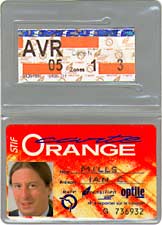When setting off a long-term backpacking trip for the first time, it's common to bring far more than needed; the uncertainty of what the trip may bring can lead to a mentality of packing things "just in case", or for comfort. Here are ten oft-packed backpacking items that, in the author's opinion, should stay in the back of your wardrobe.
1. A Huge Backpack to rival the SAS/Navy Seals
Take a stroll down the Khao San Road and you'll see wave after wave of fresh recruits arriving from overseas kitted out like Special Forces, tottering under the weight of bulging 70-80 litre capacity backpacks. Don't do it to yourself! You really shouldn't need a backpack bigger than 50 litres. Any more and you need to seriously reconsider the items you're packing. Are they really necessary?
2. Jeans
It seems like a natural choice to throw a pair or two of jeans in your bag, but denim is not suited for life on the road by any means. Jeans are thick (making you hot in balmy climates), heavy and take an age to dry. You're far better off with a pair of trousers/pants made from a lighter, quicker-drying fabric.
3. Sleeping Bag
As this is no longer the 1970s, virtually all hostels worldwide will provide you with adequate bedding for free. There is absolutely no need to bring a sleeping bag on your trip unless you are doing an awful lot of camping. Instead, consider bringing a cotton (or silk, if your budget stretches that far) sleep sheet, which will take up hardly any room at all in your pack and will be useful to separate you from the odd festering mattress you may have to lay your head on.
4. Hiking Boots
Unless you are walking around the world, leave the hiking boots at home. Big, clumpy and stinking, a pair of boots weighing down your bag will quickly become irksome, particularly when you're in a sandals climate. You're far better off hiring boots when you fancy doing some serious hiking, although a pair of sturdy trainers/sneakers will often suffice for "accessible" walks.
5. Laptop
Increasingly in dorm rooms worldwide there will be one or more travellers busily tapping away on their laptops. A laptop is a luxury item, and certainly not an essential item for backpacking, unless you require one for working en-route, so think seriously before bringing one on your trip. What might seem like a great idea at home may not be so genius on the road when it is stolen or broken.
6. SLR Camera
Hand-in-hand with a laptop on my list of no-nos is an SLR camera. You'd have to be seriously committed... to photography to bring an SLR. Heavy, bulky (especially if you bring along a selection of lenses) and prone to breaking or being pinched by shifty travellers, swallow your artistic pride and bring a crap point'n'shoot digital camera like the rest of us.
7. Enough Medical Supplies To Make Florence Nightingale Blush
One for the hypochondriacs. A compact, basic first aid kit is essential to bring with you, such as plasters, a small tube of anti-septic cream and so on. But don't go overboard. Unless you are really going way off the beaten track, leave the sterile syringes at home and put your money into comprehensive emergency travel insurance instead.
8. A Pacsafe
Don't know what a Pacsafe is? Good - keep it like that. Suffice to say, it is something your Mum would think would be a good idea. It's not.
9. Mosquito Net
Mosquito bites are intensely annoying, and need to be taken seriously, as a little nip can be deadly if the blighter is a carrier of malaria. However, there are effective ways of protecting yourself without resorting to carting a mosquito net around (such as using anti-malarials, covering up at dawn/dusk and using DEET or natural repellents). Nets take up far too much space in your pack, and are not needed in most of the world. For the areas in which you may appreciate having one, such as particularly infested parts of Africa, pick one up locally if they are not supplied at your accommodation.
10. Guitar
Because there is a common consensus that people who travel with guitars are tossers.
Steve James is currently eight months into his second round-the-world trip and has recently started putting his experiences to paper in his very own Budget Travel Guide
Article Source:
http://EzineArticles.com/?expert=Stephen_J._JamesGet The Backpacking Tips Ebook
 The first thing to do in London is have a panorama view of London, and The Eye is the place to visit!!
The first thing to do in London is have a panorama view of London, and The Eye is the place to visit!!







